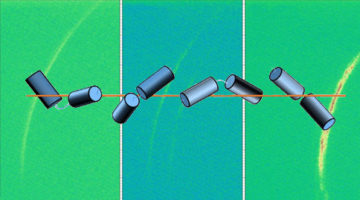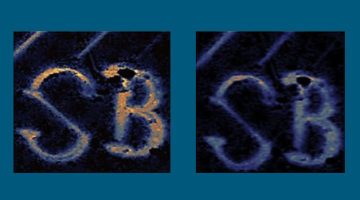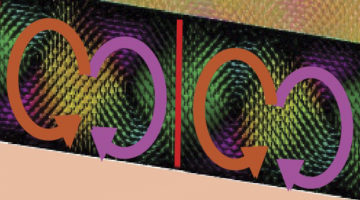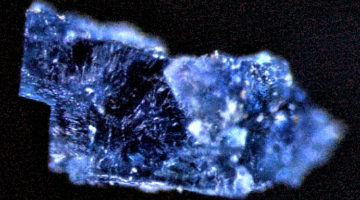The spontaneous formation of chiral structures from achiral molecules could shed light on the origin of biological homochirality—how one type of chirality dominated the other in certain biological molecules. Here, resonant soft x-ray scattering (RSoXS) has been used to explore helical phases that emerge from achiral asymmetric dimers. Read more »
Phase Diagram Leads the Way to Tailored Metamaterial Responses
Researchers discovered an innovative way to independently control two optical responses in a single-material system by utilizing the material’s phase diagram. This unique combination of material, methods, and results could lead to a paradigm shift in the design of metamaterial devices that manipulate light. Read more »![]()
![]()
X-Ray Handedness Reveals Handedness of Electronic Vortices
Electronic vortex structures have been found to emerge from engineered samples of alternating complex-oxide layers. Resonant soft x-ray diffraction (RSXD) studies using circularly polarized x-rays revealed the vortices’ left- and right-handedness. The intriguing results open the door to electrically controllable chiral devices. Read more »
COSMIC Impact: Next-Gen X-Ray Microscopy Platform Now Operational
After a first-year ramp-up for testing and tuning components, COSMIC is now operating at the ALS. The beamline brings together unique capabilities to measure the properties of materials at the nanoscale, and scientific results from its earliest experiments are expected to be published later this year. Read more »
Tuning the Electronic Structure of a 2D Material
The electronic structure of a stacked 2D material was tuned by in situ electron doping, resulting in a large increase in the splitting of two valence bands. Stacked 2D materials possess an array of tunable properties that are expected to be important for future applications in electronics and optics. Read more »![]()
![]()
Diamonds From the Deep: Study Suggests Water May Exist in Earth’s Lower Mantle
A new study suggests that water may be more common than expected at extreme depths approaching 400 miles and possibly beyond—within Earth’s lower mantle. The study explored microscopic pockets of a trapped form of crystallized water molecules in a sampling of diamonds from around the world. Read more »
Chemical Sleuthing Unravels Possible Path to the Formation of Life’s Building Blocks in Space
Experiments retrace the steps leading to the creation of complex hydrocarbons in space, showing pathways to forming 2D carbon-based nanostructures in a mix of heated gases. The study could help explain the presence of pyrene, a polycyclic aromatic hydrocarbon, and similar compounds in some meteorites. Read more »
Scientists Confirm Century-Old Speculation on the Chemistry of a High-Performance Battery
Scientists have discovered a novel chemical state of the element manganese. This chemical state, first proposed about 90 years ago, enables a high-performance, low-cost sodium-ion battery that could quickly and efficiently store and distribute energy produced by solar panels and wind turbines across the electrical grid. Read more »
Ingredients for Life Revealed in Meteorites
X-ray absorption spectroscopy and other techniques were used to measure the organic chemical components in a pair of meteorites that crashed to Earth in 1998. The study treads new ground in solar system history and asteroid geology, surfacing exciting possibilities for the existence of life elsewhere in Earth’s neighborhood. Read more »![]()
Unraveling the Complexities of Auto-Oxidation
Researchers directly observed the formation of highly oxygenated molecules—the elusive products of auto-oxidation reactions relevant to combustion and atmospheric chemistry. A better understanding of auto-oxidation mechanisms could lead to better engines, less air pollution, and improved climate models. Read more »![]()
![]()
- « Previous Page
- 1
- …
- 61
- 62
- 63
- 64
- 65
- …
- 83
- Next Page »









